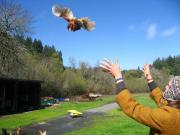...is the time I am planning to stay here in Iceland, roughly. Maybe a bit less, maybe a bit more.The Summer Course in Manuscript Studies at the Árni Magnússon Institute here in Reykjavík is finally over, and with it all this row of summer courses I took. Now it's time to start working again and take it really seriously; besides, while Europe melts in a 40°C summer heat, here it's raining, windy and it's clear summer time is gone. Hopefully I'll be able to enjoy a bit of my favourite season in Italy, i.e. autumn with its scents, melancholy for the approaching winter, roasted chestnuts, mushrooms, and the first fire coming up the chimney.The course was really good, the group was awesome, teachers included. We transcribed and edited Bartholomeus Saga Postola and the Old Icelandic translation of a Latin hymn, Personent Hodie, which we eventually even sung at the presentation. I'll most definitely go to Copenhagen next August to take the Master's Level (this year I was in the Advanced), since it's a so-called ping-pong course, alternating between the two Arnamagnæn Institues, on the Continent and in Iceland. On Sunday we went on a trip to Flatey, where the famous Flateyarbók was written; we spent nearly the whole day sitting on the bus and on the ferry, and eventually spent about 2 hours on the island, of which one and a half at the restaurant. The food was excellent though, they even arranged fancy vegan food - but besides that, we didn't do anything special, except eating harðfiskur and drinking brennivín at the arrival, and visiting Iceland's first and tiniest public library with a replica of Flateyarbók, which is now of course in Reykjavík.My friend Sarah from Belgium has just come back to Iceland - and as soon as I met her, she put a really bad bug into my head (which is not very hard...): she went back to Belgium to work for the summer, bought a used caravan for 250€, put it into a monastery's yard, and there you go. I had no idea she had lived in a caravan in Copenhagen for two years, and now I'm seriously thinking of something like that, especially if I don't want to work like a madman for the rest of my youth years instead of learning and living (check out my most recent loan from Hljómalind's library); and especially because it's very easy and cheap to find a piece of land to grow some crops on, but most of the time you're not allowed or it's just too complicated or expensive to build on it. Much better to put a carvan on it, even if it's not completely legal - I heard that in some Italian regions like Trentino, even keeping a caravan unused in your garden requires you a number plate and insurance! have you ever asked yourself who made such laws, clearly laws that no completely sane citizen could possibly agree with? So, that's why people get rid of those. I've also been reading about how to convert a caravan's chemical toilet into a compost one, although it is much more practical to do it outside the caravan, possibly as a treebog (outhouse).But going back to growing your own food. I recently found out about forest gardens - a practice linked to permaculture - what a simple and great idea... I had already read a lot of things about primitiv(ist) egalitarian societies of present and past eras, that leading a hunting-gathering lifestyle with little or no agriculture, have comparably a better and longer life and much more leisure time than agricultural societies, especially those who are founded on monocultures (like grain/extensive animal farming), whose harvest is generally poorer and threatened by fast-spreading diseases and famine. But I always regarded it as a romantic idea, that makes sense ideally but not practically; I could never imagine myself living a hunter-gatherer's life. Forest gardens are on the other hands different, since they try to reproduce a spontaneous (woodland) eco-system, rather than a landscape which is completely modelled according to the needs of a monocoltural farmer - which would not be natural, even if everything is done organically and all that. It's not spontaneous, but it can at least partially be, but it works in a way it normally does when humans are not around, the only difference being that in this case the forest is ideally entirely made up of plants that have yields directly useful to humans. The trick is finding out about so-called companion planting, i.e. planting plants on multiple levels in a way that they interact and most importantly, use the ground's resources and minerals at different levels, thus not exhausting it as a monoculture would do. It is terribly easy and it works, but as widely known, us modern people don't like simple and harmless things.When I go back to Italy in November, I will spend some days (or maybe 2-3 weeks) wwoofing in the mountains, as long as the weather is good (I remember 2 years ago I took a course in natural baking there, and we were having lunch outside on the benches and the sun was shining...), and see if I can find a job for the winter, maybe in Norway where I can make enough money and refresh my Norwegian. On Sunday I'm moving to a new room, where I will stay until the end of September.
Casa Robino
Shared Hospitality Excavations
